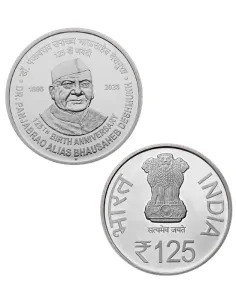
- Online only
Buy Limited Edition 100 Rupees India Govt. Mint Centenary of Komagata Maru Incident Commemorative Coin (Rs.100 Coin)
100 Rupees India Govt. Mint Centenary of Komagata Maru Incident Commemorative Coin (Rs.100 Coin)
Commemorative Coins :
India Government Mint, Mumbai also manufactures commemorative coins apart from manufacturing circulation coins. These coins are issued to commemorate events of historical and social importance and to celebrate various accomplishments of public and private organizations. India Government Mint, Mumbai has been releasing commemorative coins since 1964. The commemorative coins issued by the Mint are of very high quality and have a great demand among coin collectors and numismatists.
Commemorative coins are of two types
Proof Coins
Uncirculated Coins
Proof Coins:
Proof coins are the high quality commemorative coins which have a frozen effect on the surface design of the coin with a mirror finish. These coins are marked with the symbol 'M' to indicate that they are manufactured at Mumbai Mint. These coins are sold at a premium price as they are manufactured with high quality standards and have high numismatic value.
Uncirculated Coins:
Uncirculated coins are the high quality commemorative coins which have mirror finish on the surface but without any frozen effect on the design. These coins are marked with a diamond symbol to indicate they are stamped at Mumbai Mint. The uncirculated coins are also sold at premium but they are priced a little lower than the proof coins.
History
In 1964 production of commemorative coins was started. The first commemorative coin was in the memory of Pandit Jawaharlal Nehru.
KOMAGATA MARU
On May 23, 1914, Komagata Maru, a Japanese steamer, carrying 376 passengers from Hong Kong, mostly being immigrants from Punjab, British India, arrived in Vancouver, Canada. It was denied docking by the Canadian authorities. Following a two months stalemate, the Ship was escorted out of the harbour by the Canadian military and forced to sail back to India. The Komagata Maru arrived in Calcutta in September, 1914. The British Imperial Government saw the men on Komagata Maru as dangerous political agitators. The police went aboard the ship on 29th September, 1914 to arrest Baba Gurdit Singh and other leaders. The arrest was resisted by the passengers, which led to police firing in which 19 passengers were killed. Baba Gurdit Singh escaped along with many others. The rest of the passengers were sent to Punjab.
|
DENOMINATION OF THE COIN |
SHAPE, DIAMETER & No. OF SERRATION |
WEIGHT |
METAL COMPOSITION |
|
ONE HUNDRED RUPEES |
|
35.00 gms |
Quaternary Alloy Silver- 50 %, Copper - 40 %, Nickel- 05 % and Zinc- 05 % |
|
FIVE RUPEES |
|
6.00 gms |
Nickel Brass Copper – 75%, Zinc – 20% and Nickel – 5% |